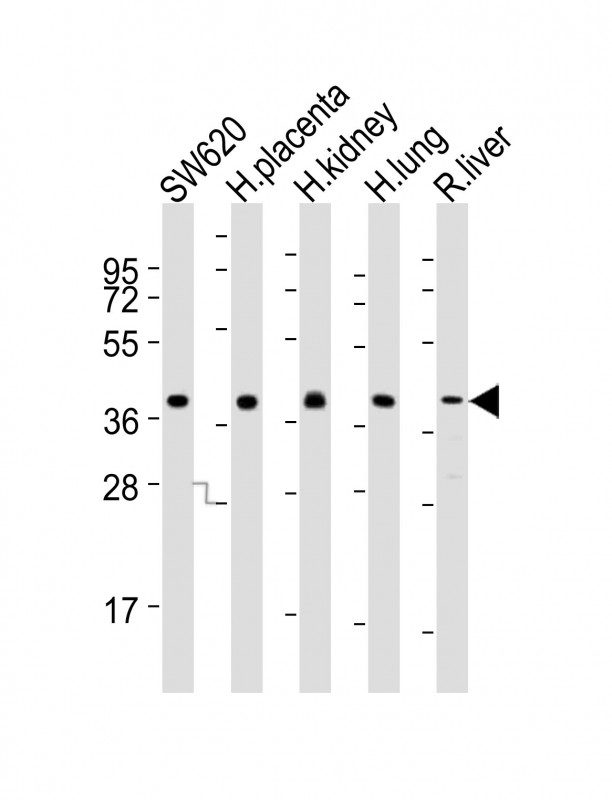PPAP2B Antibody (N-term)
Purified Rabbit Polyclonal Antibody (Pab)
- 产品详情
- 实验流程
- 背景知识
Application
| WB, E |
|---|---|
| Primary Accession | O14495 |
| Reactivity | Human, Rat, Mouse |
| Host | Rabbit |
| Clonality | polyclonal |
| Isotype | Rabbit IgG |
| Calculated MW | 35116 Da |
| Gene ID | 8613 |
|---|---|
| Other Names | Lipid phosphate phosphohydrolase 3, PAP2-beta, Phosphatidate phosphohydrolase type 2b, Phosphatidic acid phosphatase 2b, PAP-2b, PAP2b, Vascular endothelial growth factor and type I collagen-inducible protein, VCIP, PPAP2B, LPP3 |
| Target/Specificity | This PPAP2B antibody is generated from a rabbit immunized with a KLH conjugated synthetic peptide between 3~37 amino acids from the N-terminal region of human PPAP2B. |
| Dilution | WB~~1:2000 E~~Use at an assay dependent concentration. |
| Format | Purified polyclonal antibody supplied in PBS with 0.09% (W/V) sodium azide. This antibody is purified through a protein A column, followed by peptide affinity purification. |
| Storage | Maintain refrigerated at 2-8°C for up to 2 weeks. For long term storage store at -20°C in small aliquots to prevent freeze-thaw cycles. |
| Precautions | PPAP2B Antibody (N-term) is for research use only and not for use in diagnostic or therapeutic procedures. |
| Name | PLPP3 (HGNC:9229) |
|---|---|
| Synonyms | LPP3, PPAP2B |
| Function | Magnesium-independent phospholipid phosphatase of the plasma membrane that catalyzes the dephosphorylation of a variety of glycerolipid and sphingolipid phosphate esters including phosphatidate/PA, lysophosphatidate/LPA, diacylglycerol pyrophosphate/DGPP, sphingosine 1-phosphate/S1P and ceramide 1- phosphate/C1P (PubMed:27694435, PubMed:9607309, PubMed:9705349). Also acts on N-oleoyl ethanolamine phosphate/N-(9Z-octadecenoyl)- ethanolamine phosphate, a potential physiological compound (PubMed:9607309). Has both an extracellular and an intracellular phosphatase activity, allowing the hydrolysis and the cellular uptake of these bioactive lipid mediators from the milieu, regulating signal transduction in different cellular processes (PubMed:23591818, PubMed:27694435, PubMed:9607309). Through the dephosphorylation of extracellular sphingosine-1-phosphate and the regulation of its extra- and intracellular availability, plays a role in vascular homeostasis, regulating endothelial cell migration, adhesion, survival, proliferation and the production of pro-inflammatory cytokines (PubMed:27694435). By maintaining the appropriate levels of this lipid in the cerebellum, also ensure its proper development and function (By similarity). Through its intracellular lipid phosphatase activity may act in early compartments of the secretory pathway, regulating the formation of Golgi to endoplasmic reticulum retrograde transport carriers (PubMed:23591818). |
| Cellular Location | Cell membrane; Multi-pass membrane protein {ECO:0000250|UniProtKB:P97544}. Basolateral cell membrane; Multi-pass membrane protein {ECO:0000250|UniProtKB:P97544}. Endoplasmic reticulum membrane; Multi-pass membrane protein {ECO:0000250|UniProtKB:P97544}. Endoplasmic reticulum-Golgi intermediate compartment membrane; Multi- pass membrane protein {ECO:0000250|UniProtKB:P97544}. Golgi apparatus membrane; Multi-pass membrane protein {ECO:0000250|UniProtKB:P97544}. Golgi apparatus, trans-Golgi network membrane; Multi-pass membrane protein {ECO:0000250|UniProtKB:P97544}. Membrane raft; Multi-pass membrane protein {ECO:0000250|UniProtKB:P97544}. Note=Cycles between the endoplasmic reticulum and the Golgi. |
| Tissue Location | Ubiquitously expressed (PubMed:12660161, PubMed:9305923). Highly expressed in heart and placenta (PubMed:9305923). |
For Research Use Only. Not For Use In Diagnostic Procedures.
Provided below are standard protocols that you may find useful for product applications.
BACKGROUND
Catalyzes the conversion of phosphatidic acid (PA) to diacylglycerol (DG). In addition it hydrolyzes lysophosphatidic acid (LPA), ceramide-1-phosphate (C-1-P) and sphingosine-1- phosphate (S-1-P). The relative catalytic efficiency is LPA = PA > C-1-P > S-1-P. May be involved in cell adhesion and in cell-cell interactions.
REFERENCES
Kai M.,et al.J. Biol. Chem. 272:24572-24578(1997).
Roberts R.,et al.J. Biol. Chem. 273:22059-22067(1998).
Humtsoe J.O.,et al.EMBO J. 22:1539-1554(2003).
Leung D.W.,et al.Submitted (JAN-1998) to the EMBL/GenBank/DDBJ databases.
Yu W.,et al.Genome Res. 7:353-358(1997).
终于等到您。ABCEPTA(百远生物)抗体产品。
点击下方“我要评价 ”按钮提交您的反馈信息,您的反馈和评价是我们最宝贵的财富之一,
我们将在1-3个工作日内处理您的反馈信息。
如有疑问,联系:0512-88856768 tech-china@abcepta.com.























 癌症的基本特征包括细胞增殖、血管生成、迁移、凋亡逃避机制和细胞永生等。找到癌症发生过程中这些通路的关键标记物和对应的抗体用于检测至关重要。
癌症的基本特征包括细胞增殖、血管生成、迁移、凋亡逃避机制和细胞永生等。找到癌症发生过程中这些通路的关键标记物和对应的抗体用于检测至关重要。 为您推荐一个泛素化位点预测神器——泛素化分析工具,可以为您的蛋白的泛素化位点作出预测和评分。
为您推荐一个泛素化位点预测神器——泛素化分析工具,可以为您的蛋白的泛素化位点作出预测和评分。 细胞自噬受体图形绘图工具为你的蛋白的细胞受体结合位点作出预测和评分,识别结合到自噬通路中的蛋白是非常重要的,便于让我们理解自噬在正常生理、病理过程中的作用,如发育、细胞分化、神经退化性疾病、压力条件下、感染和癌症。
细胞自噬受体图形绘图工具为你的蛋白的细胞受体结合位点作出预测和评分,识别结合到自噬通路中的蛋白是非常重要的,便于让我们理解自噬在正常生理、病理过程中的作用,如发育、细胞分化、神经退化性疾病、压力条件下、感染和癌症。






